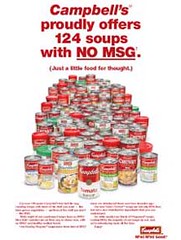
Almost every editorial on the final debate between U.S. Sen. Barack Obama and U.S. Sen. John McCain leads the same way. It only took 20 minutes before both candidates forgot about the issues and shifted toward political campaign ads.
They were kidding, right?
No, no, I suppose not. While the last reason I would elect a president is based on the prowess of their television production teams, most political talk seems to be all about the ads.
Some are even arguing over which side has more negative advertisements than the other. The University of Wisconsin Advertising Project says Obama airs the larger percentage of negative ads. The Nation says that is not true and McCain ads are much more negative. Has everyone forgotten grade school?
When Billy lies about Sally twice and Sally lies about Billy once … Ms. Clark made them both clean erasers after class.
So let's talk soup.
When it comes to negative advertising, there is no clear winner in another brand battle taking place across America. There are only losers.
For several weeks, Campbell and General Mills have been in engaged in an ongoing soup battle. Cambpell launched the first attack ad in The New York Times, claiming General Mills' Progresso soups are made with MSG. They are. General Mills fired back, saying some Campbell soups have MSG. They do.
So Campbell counted all of its soups to conclude that 124 soups have no MSG.
"The pot can't be calling the kettle black if it has the same problem itself," Laura Ries, president of Ries & Ries, told Brandweek.
So let's talk nuts.
One would think that after noted author Geoff Livingston wrote that astroturf comes in a variety of colors, including blue, someone might get the hint. Not so with Allison Copening and crew. They are dead set to stay the course with a $1 million smear campaign against State Senator Bob Beers — a campaign that almost everyone calls pathetic.
Their solution? Allison Copening's backers, who admit that the negative advertising has backfired because some residents "have stopped opening election mail” are now moving their lies onto television. Some estimate they will spend up to $500,000 on television, splitting the figure between attacking State Sen. Bob Beers and State Sen. Joe Heck, who is another elected official targeted this campaign cycle.
Given the size of the media market in Las Vegas, the television buy is equivalent to tossing a glass of water into a swimming pool and hoping to splash a few people. If it does splash some people, one can only hope that those splashed will know that most messages move beyond distortion and are of the plain old-fashioned lie variety.
As it turns out, it would not be the first time Copening has played a PR spin game. She was once a marketing director at PurchasePro, a company charged with stock fraud. She also worked as a public relations specialist for a homebuilder when it dealt with rat infestations and home fire sales that left new residents with mortgages higher than their assessed value.
She claimed that the rats were part of the allure of the desert. She rebuffed reporters when the homebuilder cut home values by simply saying they were too busy with other things.
Ironically, she claims it is Sen. Bob Beers who makes up stories. For his part, Sen. Beers has remained focused on campaign issues. In one case, he criticized a third party mailer that attacked his opponent's math skills and called them below a fourth grade level. As it turns out, he is not the only one tired of campaign ads that deviate from the truth.
Several states away in Minnesota, U.S. Sen. Norm Coleman recently said his campaign would halt negative advertising in a race recently dominated by it. "I want folks to vote for me, and not against the other folks," he said.






















